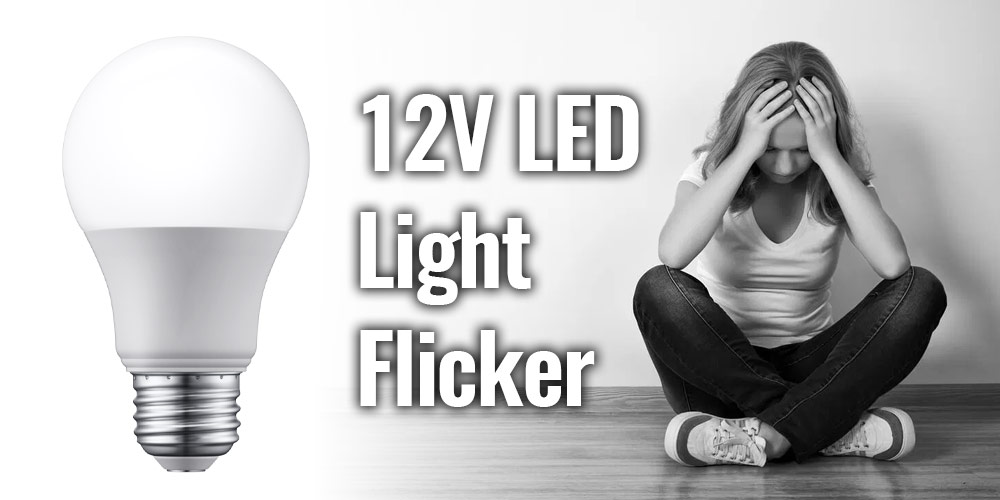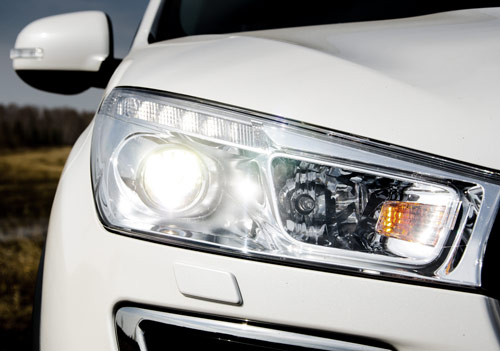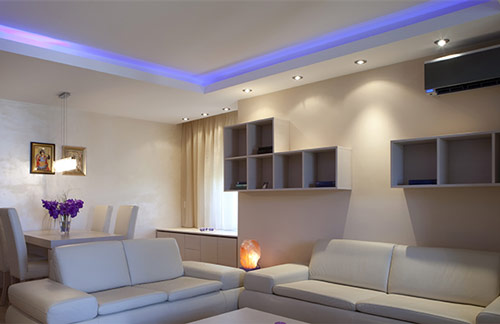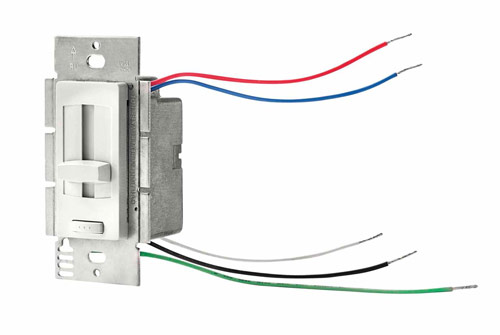
If you happen to use 12V LED light at home or office, flickering is one of the common problems you may face. To solve this issue, we need to understand what is 12V LED light and flickering. Then, we can take a look at how to fix it in this article.
What is 12v LED light and why does LED light use 12v?
The 12v LED light is known to hobby enthusiasts as the: (Light Emitting Diode), purchased from electronic repair supply stores. You can usually see these LED’s showing up in appliances and gadgets that indicate the power supply is On. In recent years the level of advanced technology has allowed the 12v LED to take on a bigger role. Since 12v LED’s consume only 3 watts of power, they became ideal for replacing incandescent light bulbs.
As for safety, the 12v LED light is the best choice to use. As mentioned before, 12 volts LED lights were the ultimate hobbyist standard go-to light. The 12v electricity flow was not quite strong enough if compared to the 120/240v line voltage. This made it perfect for hobby applications that wouldn’t leave you getting shocked. Due to the lower voltage likewise, sparks or pops with other standard line voltages for light bulbs were avoided altogether. 12v LED light is not only safer to use than regular light bulbs, but there is also less energy used. This makes the 12v LED the perfect option for cost-effective home lighting.
Not only that, the innovation of super-bright LED’s proved to be just popular for cars. Enthusiast then began the craze replacing the standard bulbs anywhere they could. But with technology comes the darker side of reality. Flashing that can come from LED lights is still a small problem that needs to be addressed.
What is Flickering? – Visible vs Invisible
No matter which brand of LED lights you purchase, some chances flicker will be present in each of them. Some 12v LED bulbs will have different manufacture specifications and electronic configurations. Some are simply poor choices that were cheaper brands. There is a lot of knock-off LED lights on the market and those cheaper ones will certainly flicker more often. We’ve broken the category into two sections so you can see what separates them from each other.
1. Visible flickering
The kind of flicker that you can see is evidently due to the frequency emitted by the LED bulb itself. Anything that has a frequency of 100Hz will be visible to the naked eye. The LED flickering will often cause the brain to interpret this presence as a slow-motion effect. And while it does carry possible side-effects (which are discussed later in this article), we will address each of them. As all LED lights are flickering, the right kind of voltage is needed to ensure they flicker less noticeably. These come in the form of power strips that are used to increase the direct voltage required. You can find them being sold in the outlets where LED lights and products are readily available.
2. Invisible flickering
Though this type of flickering is not visible to the naked eye, it is caused by rapid light fluctuations. Within a matter of seconds, the flickering is seen through electronic devices. Cameras especially can see a tracking effect called a ‘trail’, which is stroboscopic by definition. It can even be seen as a vertical streaking line in digital photos proving the flickering is present. Invisible flickering is also the result of the correct voltage that is given to an LED lamp. You don’t notice any flashing since your eyes are not built to sense the number of flashes per second. If you take pictures with a digital camera where there are LED lights, you might just catch this anomaly in action.
Why do 12v LED lights have a flickering problem that’s common?
There are selective reasons as to why the LED lights will flicker in various applications. Either used at home, or in your car, they can be present for several reasons. The manufacturers of these new lighting fixtures will all have different specifications for working with the recommended electrical current. Suffice to say that flickering is seen in any kind of light bulb that you happen to use.
Filament bulbs can flicker because the current that is used runs in cycles. You seldom see this all because the filament is burning continuously and there’s no time to see visible light changes. Those of us who use these 12v LED lights in a car or at home will experience a flickering problem. As we begin, keep in mind that LED lighting is not an exact science. Flickering is a problem currently, so we will do our best to describe where it happens and how to fix it. By the end of this article, you’ll have a better understanding of this problem you can solve by yourself.
1. In a Car
 Flickering LED lights in your car are not a good sign, so finding the cause of that is very important. Starting with the interior lights, if you have swapped out filament bulbs for 12v LED’s, you might have noticed strobing. This can be connected to several reasons that this is happening. Check all the connections or fuses that run the interior lights. If you have a loose connection for the LED itself, the vibration from driving will cause all sorts of flicker. Then again, a fuse that’s getting old or going bad will cause the LED light to have a flickering problem.
Flickering LED lights in your car are not a good sign, so finding the cause of that is very important. Starting with the interior lights, if you have swapped out filament bulbs for 12v LED’s, you might have noticed strobing. This can be connected to several reasons that this is happening. Check all the connections or fuses that run the interior lights. If you have a loose connection for the LED itself, the vibration from driving will cause all sorts of flicker. Then again, a fuse that’s getting old or going bad will cause the LED light to have a flickering problem.
Headlamps, brake lamps, and fog lights all can run off the 12v system with super bright capacity. There is also the risk of flickering that can happen for many more reasons. One main reason has to fall back on the car battery itself. The car battery is what powers the exterior lights at all times. Many cars lose their power really quick if you forget to turn them off. A low battery can be terrible for LED headlamps which need an exact amount of power to operate. This may also be assigned that your alternator is starting to fail.
Besides that, super-bright headlamps or any kind of exterior LED lamps for cars do have a set lifetime. When it’s their time to go, the signs can start with flickering, strobing, and even blinking. Be prepared to have a new replacement for them as soon as possible. Avoid any kind of potential accident that can result in poorly maintained LED lamps for your car.
2. At Home
 The benefit of electricity in your home will vary in forms with either direct current or altered current (AC/DC) being used. Your home is typically wired for AC. This form of altered current is considered safer than DC for obvious reasons. Ask any electrician friend and they tell you why, but in a nutshell, here is the reason. AC was well established through the efforts of Nicolas Tesla back in 1896 to power Buffalo, NY. Currently, it provides a steadier form of current to homes and businesses throughout the USA.
The benefit of electricity in your home will vary in forms with either direct current or altered current (AC/DC) being used. Your home is typically wired for AC. This form of altered current is considered safer than DC for obvious reasons. Ask any electrician friend and they tell you why, but in a nutshell, here is the reason. AC was well established through the efforts of Nicolas Tesla back in 1896 to power Buffalo, NY. Currently, it provides a steadier form of current to homes and businesses throughout the USA.
Though this doesn’t translate well for LED lights, these prefer a direct current for the semiconductor to light up properly. The alternating current is delivered at 50Hz and is continuously switching backward 50x a second. This can cause your LED bulbs to flicker due to this cycling of electric current. Even though many appliances convert the AC into DC power, this is overlooked by many people who use LED lights. If improperly installed into a home, the flickering is a constant reminder that AC voltage is being used. Luckily, there are ways to fix this problem with additional hardware as you read on further.
See also: Common problems of LED lights
What would happen if we don’t tackle the flickering LED light problem?
Any number of problems that come from the flickering light that can come from a pesky LED light. The allure of saving money using 12v LED’s is often the pitfall most of us fall into along the way. So how do we solve the potential headaches that can occur? Here are some common problems that have come up with LED lights, and how they can be easily fixed. Most of these are problems that don’t need costly upkeep or servicing, as you can solve most of them yourself. Take some time to look at these informative tips, to increase better safety for you, in your home or car.
1. In a car
The likelihood of an accident due to the fault of a driver depends on the awareness you have of the vehicle around you. Your car is no exception and should always have a spot checklist each time your drive. Faulty equipment such as burned-out headlamps, tail lights, and driving lights all impair your visibilities to other vehicles. This should be an extra consideration when LED lights are used too.
a. Safety for you
You’ll need to begin with the interior since this is essentially the cockpit that controls everything.
Make sure that all car interior light is in working order, even the LED lights that have been replaced. These can have problems that will no doubt come back to technical reasons for the LED light to be distracting. A flashing or strobing LED is a danger for your focus while driving. One wrong second of taking your eyes off the road can be dangerous for you and others in the car.
The exterior of the car presents another hidden danger since LED lights can fail at any time. Headlamps that flicker can be irritating, though if they haven’t done that before, it’s time they need fixing. Check the cables that connect them and if the problem persists, it could get worse if they suddenly go out. Always have a spare of each LED light in the trunk just in case. Since this light is not as expensive as they were a decade ago, your ‘repair kit’ should include them too. Always make sure that you keep track of the amount of time they are used. They all have an estimated lifetime.
b. Safety for others
Night driving requires a lot more visuals to let other cars know you are in the opposite lane. Using any kind of ultra-bright LED lamp should impair the drivers around you or close to you. Making sure your headlamps are directed and focused on the road is equally important. You never want to blind the opposite driver with LED lights, the intensity is just too bright. Another thing to consider is that flickering LED lights may even cause photosensitive epilepsy, causing seizures.
The worst thing that could happen is causing another driver (or yourself), to have a seizure and crash the car. Make an all-point check before you start driving, to ensure LED lights in your car are working correctly. If the interior lights are too bright, you can use tinted warm yellow foil around them to reduce harsh glare. Auto repair stores readily sell these tinted foils in packs and don’t melt since LED light produces little heat. Another tip is to always test the LED bulbs before you use them in your car. Your garage is the perfect place to adjust and refine LED lights until they suit your liking.
2. At home
Still, the unforeseen risks of LED lights in your home can cause various side-effects that affect your mood and more. Worse yet, because of the visible flashing that can happen due to bad installation can bring around these possible ailments. They don’t happen instantly, though prolonged usage will include these symptoms.
a. Eye discomfort
 If you have ever worked under fluorescent lights for a while, you may have noticed how they tire your eyes. The same can occur with LED lights for extended periods. Sure- these lights are brighter and are color corrected to produce more of a sunlight temperature, but… Improperly installed reading lamps or room lights can eventually tire the eyes and even experience dry itchy eyes too. Chose a correct color temperature LED bulb to balance the harshness. The newer 12v LED lights have four different hues to warm-up the room and spare your eyes also.
If you have ever worked under fluorescent lights for a while, you may have noticed how they tire your eyes. The same can occur with LED lights for extended periods. Sure- these lights are brighter and are color corrected to produce more of a sunlight temperature, but… Improperly installed reading lamps or room lights can eventually tire the eyes and even experience dry itchy eyes too. Chose a correct color temperature LED bulb to balance the harshness. The newer 12v LED lights have four different hues to warm-up the room and spare your eyes also.
b. Headaches
Commonly, LED lights can cause headaches for whatever reason. The temperature of the light itself also falls into this category along with the lighting-quick rapid flashing. To prevent this from happening, the answer is to not stay in the same room all day long. Take breaks and move from room to room to adjust to different light sources. Better yet, go outside in the sunlight to clear your head for 5 minutes. This way you can avoid the constant vibration of LED light that can occur. Even for a short trip to the kitchen can avoid the onset of a headache.
c. Fatigue
Getting tired while sitting in one spot is unavoidable for some when you’re at home. It can happen from watching TV, playing video games, or even sitting at the computer. Most people will forget that LED lights can be distracting due to their white glare. The simple answer is to turn them off and enjoy the natural light that comes from a window. The effects of natural sunlight cause our bodies to feel energized and lively. If you are feeling fatigued from your LED lamp, turn it off.
Why do 12v LED lights flicker, and how to fix the problem?
If you are experiencing the flicker problems with your LED lights, there is an answer that solves the problem. You don’t need to study electronics to find out what causes the problem, these tips will help you fix it. In most cases, the problem is not with your LED itself but alternate forces at work. In the end, each of these listed problems can readily be stopped for good. Or to say the least, reduced to a level that is safer and healthier for you. Scan through these selections to find your problem you want to solve.
1. Wrong dimmer switch
 Let’s say that you’ve bought an LED light that is screwed into a lamp with a dimmer switch and it doesn’t work. This is because that LED was made to working at a constant brightness. Only LED lights that are marked specifically for dimming can be used, otherwise they flicker like crazy. These LED lights that are dimmer friendly will work on any dimmer control after that.
Let’s say that you’ve bought an LED light that is screwed into a lamp with a dimmer switch and it doesn’t work. This is because that LED was made to working at a constant brightness. Only LED lights that are marked specifically for dimming can be used, otherwise they flicker like crazy. These LED lights that are dimmer friendly will work on any dimmer control after that.
2. Flickers without dimmer
When you buy a brand new LED blub there will be some flashing as it gets to the correct temperature. But if the flashing continues longer than a minute or two, perhaps longer- the bulb is faulty. That flashing is the indicator that it’s going to die soon, so it’s best to get a refund or exchange.
3. Other reasons
Perhaps it’s not your fault at all that the bulb has gone bad or is the wrong type of LED to use. This section is for other variants that you might expect to find LED flashing problems.
4. Wrong LED power supply
That power supply that most lamps are plugging into will keep you LED flickering whether you see it or not. You can reduce this by using PDV LED drivers that are designed to provide constant voltage to the LED bulb. This will improve how the light is supposed to light up correctly, greatly reducing flashing that you can notice.
5. When switched on
Try it for yourself and switch on an LED lamp to see the number of multiple flashes it takes to start-up. Depending on your PDV LED driver, you might not be the correct driver to get direct current to the bulb. It may even be that you should check the contact points and make sure the bulb is screwed in securely.
6. When they flicker sometimes
These can be fluctuations in the power grid, too small a power supply built into the LED light or even signs that the lamp will die soon. Try switching the lamp to another outlet to see if there is an improvement. If it persists, the end of the LED light is most likely coming soon. Then it’s time to buy a new bulb.
a. On a motion detector
If you see that your motion detector is actively sensing something, it can be flashing from a faulty LED bulb. The sensor uses an electronic switch sensor to track motion, however, they can be fooled by a flashing LED light too. Sorry, it’s not a ghost this time- but perhaps the fault of your dying LED lamp instead.
b. On portable LED lamps
Those 12v handheld lamps are great for nearly everything and then they start to give you the shivers. No big surprise if you find that the batteries are running on low. To keep these handheld flashlights handy, you should keep a ready supply of batteries on hand. You never know when the power might go out. So, having one or two of these handheld lights is pretty handy all the same.
c. On an electrical transformer
If you own a house where there is a transformer that turns on or off, all sections of the house. The newer transformers have 12v LED lights that indicate the 120v power grid is working or not. If you see that the LED’s are flashing rapidly, it can mean that the output of your transformer is bad. At that point, it will be necessary to call an electrician to replace the transformer.
Why do LED lights flicker when turned off?
This can happen when the LED light is turned off and for some time can still flicker shortly after. The reason is not hard to explain since the voltage that is cut does not stop instantly. Left-over electricity can also surge into the electrical wire if it’s wired incorrectly. Even a switch that controls a night light can cause a temporary surge to make a LED light flicker.
What are intermittent flickering LED lights?
This is an anomaly that stems from the use of a dimmer, or inconsistent voltage. Without using the proper PDV LED driver, an LED bulb will have flashing, strobing and blinking problems. These types of bulbs need constant voltage to work their best. It may also be a sign that the bulb is defective in the wiring too. Using cheaper LED lamps that are produced overseas in China is a sure sign that the bulb is ready to die. Spend the extra money and buy a reliable LED bulb from quality brand names. The extra you pay for a top LED bulb is worth ever hour that is specified on the box.